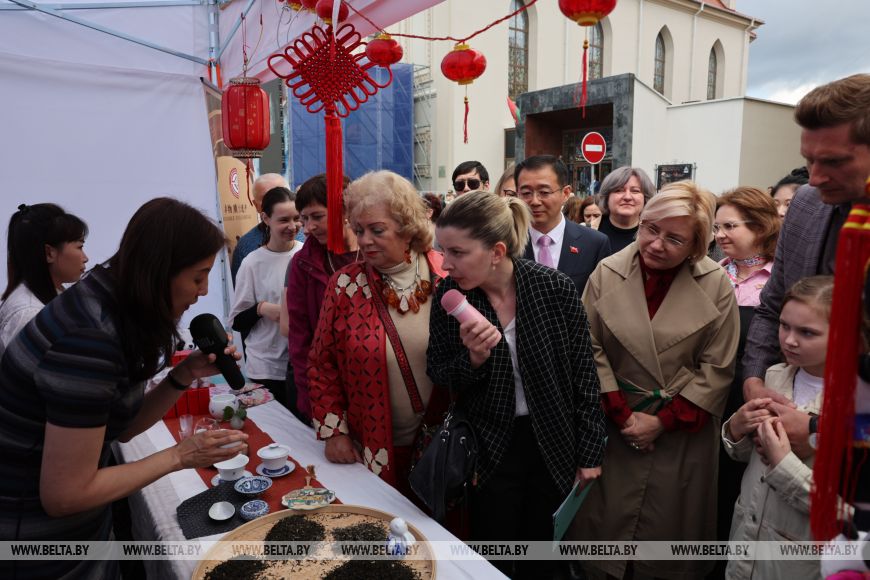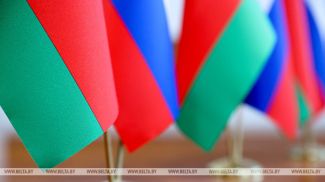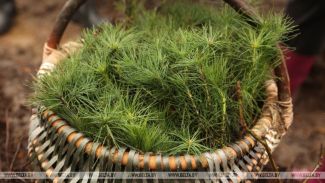
Zhang Wenchuan
MINSK, 31 May (BelTA) - Tea has become a cultural symbol of Chinese-Belarusian friendship and a link for mutual cultural enrichment between the peoples of the two countries, Ambassador Extraordinary and Plenipotentiary of China to Belarus Zhang Wenchuan said at the Tea for Harmony event in Minsk on 31 May, BelTA has learned.
He expressed his gratitude to Minsk City Hall for its assistance in the organization of the event, welcomed the delegation from Tianjin, and thanked all the Chinese and Belarusian staff who had helped prepare for the event.
“Tea for Harmony has become a brand of humanitarian exchange between China and Belarus,” the diplomat said. “Every year at the start of summer, we gather here to enjoy the taste of tea and learn about the cultural traditions and folk customs of China. This year, we are fortunate to have friends from Tianjin here. Today, everyone will have the opportunity to try Tianjin jasmine tea, which has a history of more than 200 years, and traditional Chinese treats, get familiar with Tianjin's intangible cultural heritage — colorful clay figurines and openwork embroidery, enjoy lively performances by Chinese and Belarusian folk groups, and take part in a variety of interactive events dedicated to traditional Chinese culture.”

The ambassador expressed confidence that the event would be another grand occasion in the cultural dialogue between the two countries.
The head of the diplomatic mission also spoke about Chinese tea culture: “Tea is an epic of Chinese civilization in miniature. According to historical data, the cultivation and production of tea in China dates back more than 3,000 years, thanks to which the country rightfully bears the title of the birthplace of tea. The Tea Canon was written by Lu Yu (Tang Dinasty) 1,200 years ago. The treatise is the earliest, most complete, and comprehensive work on tea in China and even in the world, earning it the title of ‘tea encyclopedia’. Today, China is the world's largest producer, consumer, and important exporter of tea. From the western borders to the eastern coast, from the southern hills to the northern highlands, each region is proud of its unique tea variety. Jasmine tea, brought by the Tianjin delegation, is a worthy representative of Tianjin's tea varieties.”
The ambassador noted that in November 2022 the traditional tea processing techniques and their associated social practices in China were added to UNESCO's Representative List of the Intangible Cultural Heritage of Humanity, marking the recognition of tea culture, which originated in China, as a common heritage of human civilization.
“Tea is the philosophy of the Chinese people's way of life. Tea embodies the wisdom of life based on harmonious coexistence and adaptation to local conditions,” the diplomat continued. “Residents of different regions, adapting to different natural rhythms, have developed a variety of technologies, creating more than 2,000 types of tea, which together form a brilliant and multifaceted tea culture. Tea reflects the cultural essence of modesty and reverence, respect for elders, and the tradition of hospitality. Tea also embodies the pursuit of self-improvement and peace of mind. The process of drinking tea requires patience—the water temperature, the amount of tea leaves, and the brewing time must be perfectly balanced. People expect that the thoughtful and calm process of drinking tea will bring mental balance and spiritual strength. As the Chinese figuratively say, “when tea leaves sink from the surface of the water to the bottom during the brewing process, a person's mood also changes along with them — from restlessness to calm.”
“Tea is a universal language of dialogue between civilizations. Tea is not only a symbol of Chinese culture, but also a ‘green messenger’ connecting Chinese civilization with the world. Since the Han and Tang dynasties, tea and tea culture, which originated in China, have spread throughout the world via the Great Silk Road, the Ancient Tea Horse Road, and the Great Tea Road, crossing mountains and oceans, becoming an important bridge for dialogue between different civilizations. Throughout this process, peace has remained a constant theme. Through the taste of Chinese tea, the peoples of the world learn the philosophy of harmony as the highest value and of finding common ground despite differences, and through the art of the tea ceremony, they learn the Eastern wisdom of peaceful coexistence and mutual assistance. In 2019, the 74th session of the UN General Assembly proclaimed 21 May as International Tea Day. The use of tea to strengthen good neighborly relations and make friends has become a global trend,” said Zhang Wenchuan.













